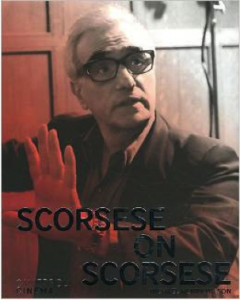Director’s Backstory, Dark and Light
Scorsese on Scorsese by Michael Henry Wilson (2012, Cahiers du Cinema)
If a maverick is, by his own admission, “a filmmaker who finds a way with the system of making the films he has chosen to make”, Martin Scorsese is certainly one. From his early works, directly emanating from the ethnic melting pot of New York’s Lower East Side where he grew up, to his latest Oscar-winning celebration of the dream factory, Hugo (2011), Scorsese has worked his way up in the film industry within and outside the system, “above ground” and “underground”, in and out of Hollywood, putting onto film his deepest obsessions.
Spanning his 50-year career, the 320-page volume Scorsese on Scorsese encompasses the director’s entire oeuvre, from his short films of the early 60s to his present-day projects, providing a unique insight into the creative processes of the man whom British film director Michael Powell described as “the Goya of 10th Street”. The book, published by Cahiers du Cinema, is a work of art in itself, collects the interviews that Scorsese gave throughout his career – from 1974 to 2011 – to his friend Michael Henry Wilson and includes a stunning documentation taken from his personal archives: family photographs, photographs taken on set, original scripts, sketches, notes and storyboards, as well as a biography and a complete filmography.

What emerges from this beautiful book is the portrait of a “tormented poet” able to display the drama of human life in all its complexity, through larger-than-life characters torn between genius and madness, always dangerously on the verge of insane obsession.
All his films are indeed “opere mondo” – literally “world works” or “modern epics”, as Italian literary scholar Franco Moretti would put it – drawing their imagery from “the violence of the streets and the frenzy of rock music, the mysteries of religion and the spell of show business”.
The grandson of Sicilian immigrants, Scorsese has always thought of himself as an “American Italian” rather than an “Italian American” like his parents. From his family background he inherited a strong sense of religion, which permeates his entire oeuvre. After all, as he once said, “when you grow up in Little Italy what are you going to be other than a gangster or a priest?”
If the outbreak of rock’n’roll pulled him away from the Church, a career as a gangster was not an option either, as he was the guy who got always beaten up. So filmmaking was the route he had to take in order to survive. (“You make art because you have to, because you have no choice” – says the painter in Life Lessons, 1989).
His debut as a filmmaker in the 1960s was like “the arrival of an alien from outer space.” He burst upon the scene with Mean Street (1973), his “Italian-American Graffiti”, and three years later, he was awarded the Palme d’Or in Cannes for Taxi Driver (1976), which marked the start of a series of fruitful collaborations between Scorsese and screenwriter Paul Schrader and sealed his symbiotic relationship with his actor of choice, Robert De Niro.
With New York, New York (1977), his first big Hollywood production, he subverted the conventions of the musical biopic, creating a “Pirandellian exercise on the perils of show business”. His reflection about the self-destructive impulses hidden behind the lavish spectacle continued with The Last Waltz (1978), a concert documentary paying homage to the rock revolution.
The 1980s were the years of unforgotten masterpieces, such as: Raging Bull (1980), another proof of the alchemical synergy between the director and his actor Robert De Niro; The Color of Money (1986), where the confrontation between Paul Newman and Tom Cruise is one between two Hollywood generations; and The Last Temptation of Christ (1988), the spiritual odyssey of a “human all too human” Christ, different from the saintly figure of the hagiographies.
The following decade opened up with the gangster epic Goodfellas (1990) and the Hitchcockian thriller Cape Fear (1991), followed by the period drama The Age of Innocence (1993) and Casino (1995), a story of crime and punishment which gained a reputation as the most violent American gangster film ever made. Kundun (1997), an account of the early life of the 14th Dalai Lama, was his second attempt to profile the life of a great religious leader, carrying out a reflection on the power of compassion which would be further explored by Bringing Out The Dead (1999).
Over the last 20 years, Scorsese has hit the mark again, with such works as the historical epic Gangs of New York (2002), entirely filmed at Rome’s famous Cinecittà film studios; The Aviator (2004), the compelling story of a modern Icarus doomed to fall; the Oscar-winning crime thriller The Departed (2006); the Rolling Stones concert film Shine a Light (2008); the labyrinthine psychological thriller Shutter Island (2010) and the television series Boardwalk Empire (2010).
The five Oscars for his 3D adventure film Hugo (2011) are nothing but the umpteenth confirmation of the talent of this extraordinarily prolific auteur, whose creativity continues to be fueled by “an inextinguishable flame, as strong as the one that consumes his saints and sinners”, as the author concludes in the epilogue of the book. His addiction to filmmaking couldn’t be expressed better than by Frank Capra’s words: “Film is a disease. When it infects your bloodstream, it takes over as the number one hormone; it bosses the enzymes; directs the pineal gland; plays Iago to your psyche. As with heroin, the antidote for film is more film.” That being the case, we can’t help but wait for what comes next.
Laura Giacalone is the Associate Editor for the Italian Journal.
